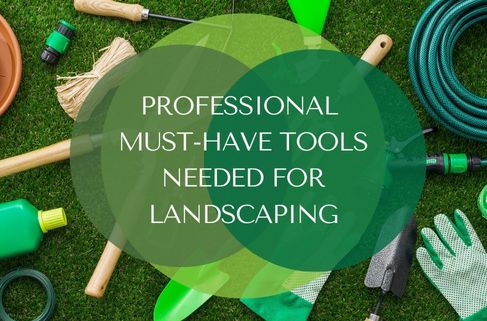Professional Must-Have Tools Needed for Landscaping

Table of Contents
Landscaping not only transforms outdoor spaces but also brings creative visions to life. It requires skill, artistry, and the right set of tools. Whether you’re pruning shrubs, laying sod, or building a water feature, having the appropriate equipment is essential for efficiency and quality results.
Why Do You Need Heavy-Duty Tools for Professional Landscaping?
The landscaping industry demands a lot from its professionals, including creativity, precision, and the ability to transform any outdoor space into a functional work of art. However, accomplishing these feats isn’t solely based on skill and vision; it’s also about utilizing the right equipment. Specifically, heavy-duty tools needed for landscaping are non-negotiable for those who take on this demanding work. But why is that?
Durability Meets Demanding Workloads
Landscaping isn’t just about planting flowers or trimming hedges. It encompasses many tasks, from soil preparation and grading to tree removal and constructing hardscapes like patios or retaining walls. These tasks require tools that withstand heavy loads, constant use, and harsh outdoor elements. Heavy-duty tools are built to last, ensuring that your investment doesn’t break down in the middle of a job. This reliability is important for professionals who cannot afford delays or equipment failures during projects.
Efficiency and Productivity
Time is a critical factor in the landscaping business. Projects must be completed within set deadlines, and any tool that can speed up the process without compromising quality is vital. Heavy-duty equipment, with its enhanced power and capabilities, can cover more ground quickly. For instance, a commercial-grade lawn mower cuts more grass with each pass than a residential model, and a powerful tiller prepares soil much faster than manual tools. This efficiency boosts productivity and allows landscapers to take on more projects, directly impacting profitability.
Safety is Paramount
Professional landscaping involves tasks that pose significant injury risks. Using tools that are not up to the job can increase these risks. Heavy-duty tools are designed with safety features that minimize the chance of accidents. For example, professional-grade chainsaws have better safety guards and anti-vibration systems to protect users. Moreover, the right tools reduce the need for makeshift solutions that can put landscapers in danger, ensuring that projects progress smoothly and safely.
Versatility for Creativity
Clients often have specific visions for their outdoor spaces, from exotic garden designs to intricate landscape features. Achieving these visions requires a level of versatility that only heavy-duty tools can provide. These tools come with attachments and features that allow for customization, enabling landscapers to execute various designs and tasks. Whether crafting a meticulous water feature or shaping a precise hedge design, the right tools allow professionals to bring creative visions to life.
Professionalism and Reputation
The tools needed for landscaping and the outcomes they produce speak volumes about a professional’s commitment to their craft. High-quality, heavy-duty tools facilitate better results and project an image of professionalism. Clients are more likely to trust and recommend landscapers who invest in the right equipment. This professionalism also extends to employees; using industry-standard tools can boost morale and encourage a higher standard of work.
Making the Investment
While the initial cost of heavy-duty landscaping tools may be higher, they are an investment that pays off in the long run. Their durability means less frequent replacements and their efficiency translates to more completed projects and happier clients. Moreover, investing in the right tools needed for landscaping reflects a commitment to quality work, safety, and professionalism, all of which contribute to building a reputable landscaping business.
Essential Toolkit for Professional Landscaping
Core Gardening Tools
The core gardening tools are at the heart of any landscaping toolkit. These include shovels, rakes, and hoes, indispensable for digging soil preparation and weed removal. A high-quality shovel is essential for digging and moving soil, while a sturdy rake helps clear debris and spread mulch. The hoe is invaluable for its versatility in soil cultivation and weed control.
Precision Cutting and Trimming Tools
Precision cutting and trimming are among the landscaping tools needed to achieve meticulously manicured gardens. This category includes pruning shears, hedge trimmers, and chainsaws. Pruning shears are perfect for snipping branches and shaping bushes, ensuring healthy growth and aesthetic appeal. Electric or gas-powered hedge trimmers provide the power to create clean lines and even surfaces for larger hedges and bushes. Chainsaws are essential for cutting down large branches and trees, facilitating major landscape changes.
Soil Enrichment and Plant Care
A thriving landscape is built on healthy soil and well-cared-for plants. Tools like a soil knife, garden forks, and a wheelbarrow are essential in this regard. A soil knife is indispensable for weeding and planting, a garden fork for turning soil, and a wheelbarrow for transporting soil, compost, and other materials across the garden. These tools ensure the soil is well-prepared and fertile, providing a strong foundation for plant growth.
Landscaping Power Tools
Power tools can significantly decrease the workforce and time for more extensive landscaping projects. Essential power tools include a rototiller for soil preparation, a leaf blower for clearing leaves and debris, and a lawnmower for maintaining pristine lawns. A rototiller breaks up the soil, making it easier to plant and landscape large areas. Leaf blowers and lawnmowers are necessary for the upkeep of gardens, ensuring they remain clean and tidy.
Watering and Irrigation Equipment
Proper hydration is key to maintaining a vibrant landscape. Beyond simple garden hoses and watering cans, professional landscaping calls for more sophisticated systems. This category includes tools needed for landscaping, such as sprinkler systems for lawn watering and drip irrigation systems for direct plant watering. These tools ensure that water is distributed efficiently and evenly across the landscape, promoting healthy plant growth without wastage.
Safety and Protective Gear
Safety should never be overlooked when discussing tools needed for landscaping. Protective gloves, goggles, ear protection, and sturdy boots are essential safety equipment. They protect the landscaper from potential injuries, such as cuts, debris in the eyes, and hearing damage from loud machinery. Safety gear ensures that landscaping work can be performed without risking personal health.
Specialized Tools for Unique Tasks
Landscaping encompasses many activities, and some may require specialized tools. For instance, installing hardscapes like walkways and patios would necessitate masonry tools, such as trowels, chisels, and mallets. Similarly, creating water features might require submersible pumps and pond liners. Knowing and having access to these specialized tools as needed for landscaping-specific features can expand professional landscapers’ services.
How to Take Care of Essential Tools Needed for Professional Landscaping
Cleanliness is Key
Tools are often dirty after work and may have soil or sap. Cleaning your tools is one of the simplest yet most effective ways to keep them in good condition. Tools like shovels, trowels, and pruning shears should be washed to remove dirt. For stubborn sap or resin, using a solvent like rubbing alcohol can help. Regular cleaning prevents the buildup of harmful substances that can degrade the tools.
For tools that come into contact with diseased plants, sterilization is important to prevent the spread of disease. Wiping the blades with bleach and water can kill lingering pathogens, ensuring your tools don’t become a vehicle for disease in your landscape.
Sharp Tools for the Sharp Landscaper
A sharp tool makes your work easier and ensures a clean cut, which is healthier for plants. Tools that have become blunt, such as pruning shears, hedge trimmers, and mower blades, need regular sharpening. Sharpening can be done using a file or sharpening stone, following the angle of the original edge. It’s a skill worth learning for anyone serious about keeping the tools needed for landscaping in top shape.
Rust Prevention
Moisture is the enemy of metal tools, leading to rust and corrosion. Tools should be thoroughly dried before storage. Applying a light coat of oil to metal parts can create a barrier against moisture. Even household items like vegetable oil can work for this purpose. Storing tools in a dry, protected area further reduces the risk of rust, ensuring your tools stay in good condition for longer.
Proper Storage Solutions
A cluttered workspace can damage tools and be hazardous. Investing in proper storage solutions like racks, hooks, or sheds helps organize your landscaping tools effectively. This makes it easier to find the right tool when needed and protects them from damage from improper stacking or knocking over.
Additionally, it is important to store power tools according to manufacturer instructions. This often means removing batteries, draining fluids, and cleaning filters for long-term storage.
Regular Maintenance Checks
Just as a landscaper assesses a garden, tools also need regular checks. This involves inspecting any loose parts, damaged handles, or dull blades. Tools like lawnmowers and leaf blowers, being more complex, may need professional servicing to check their engines and internal components. Regular maintenance ensures that the tools needed for landscaping are safe to use and operate at their best.
Personal Care Equipment
While maintaining landscaping tools, remember personal protective gear. Items such as gloves, goggles, and boots also require cleaning and inspection to ensure they’re in condition to provide the necessary protection during landscaping tasks.
Handle With Care
Tools’ handles, whether made of wood or plastic, need attention, too. Wooden handles can be sanded to remove splinters and then treated with linseed oil to prevent drying and cracking. Regular inspection for cracks or breaks in plastic handles is key, as these can compromise the tool’s safety and effectiveness.
Saving Watering and Irrigation Tools
Watering equipment such as hoses and sprinklers benefits from being drained and stored correctly, especially in cold climates where water inside can freeze and damage the tools. Regularly checking for leaks and blockages can also save you from potential headaches.
Final Thoughts
The tools needed for landscaping are as varied and complex as the projects you may encounter. From simple hand tools for basic gardening tasks to powerful machines for major landscape renovations, each tool has a specific role that helps bring a landscaping vision to life.
Moreover, with technological advancements, tools like landscaping software have become just as important as shovels and rakes. For anyone serious about landscaping, having a well-equipped toolkit is essential.
It ensures efficiency, quality, and safety in transforming outdoor spaces. Whether you are just starting out or looking to upgrade your equipment, these are the must-have tools.
At Landscape Website Design, we specialize in creating stunning, fully managed websites that are perfect for lawn care businesses like yours.
Join our many satisfied customers and see the amazing impact a well-designed website can have on your business. Don’t hesitate to check out our services today or contact us directly to schedule your free discovery call.
Let us handle the technical stuff so you can focus on growing your business.
Start-up essentials for a landscape and gardening business:
- 17 Creative Lawn Mowing Business Names
- Tips To Grow Your Landscaping Business During Slow Months
- How To Start a Landscaping Business
- How to start a Lawn Care Business: What You Need to Know
- How to Start a Successful Landscaping Business Website
- Landscaping Website During Winter
- Free vs Paid Website Builder for Landscaping Business
- 8 Landscape Design Logo Example for Your Inspiration
- Budget-Friendly Lawn Care Equipment List for Your Business
- What To Do Once You Have a Website for Your Landscaping Business
- SEO For Landscaping Company
- The Top Ten Best Landscaping Company Websites
- Your Quick Guide: Lawn Care Website Design Ideas
- 3 Landscaping Website Design Examples
- The Ultimate Guide for Landscaping Company Logo Ideas
- Key Elements of The Best Lawn Care Websites
- Top 10 Landscaping Companies for your Design Ideas
- Exploring 16 Lawncare Web Design Features For Your Future Reference
- Create a Stunning Landscape Company Website with the Best Website Builder
- How to Make a Lawn Care Website
- Why Web Design Matters For Your Lawn Care Biz
If you need help, check out our offers below:
